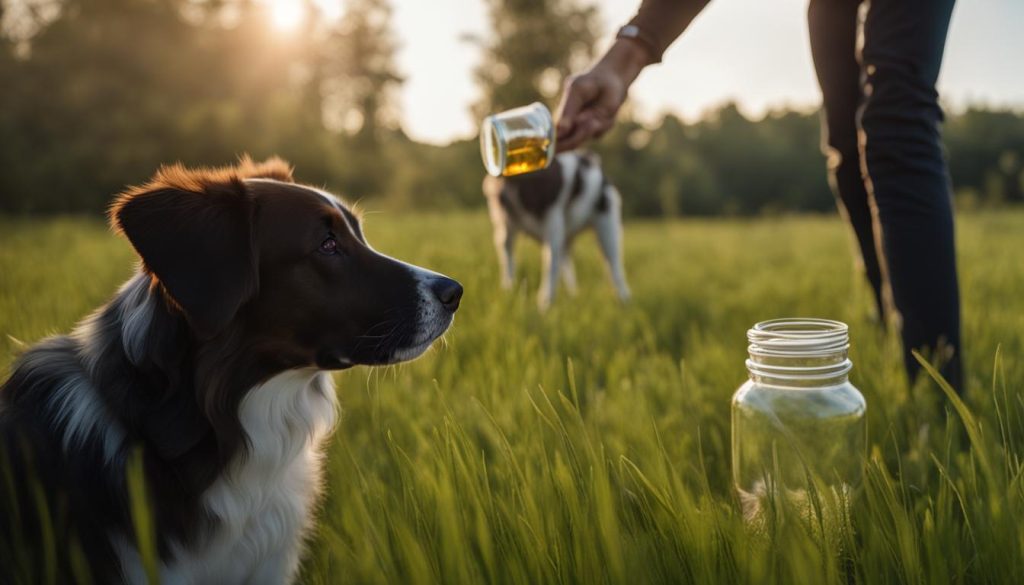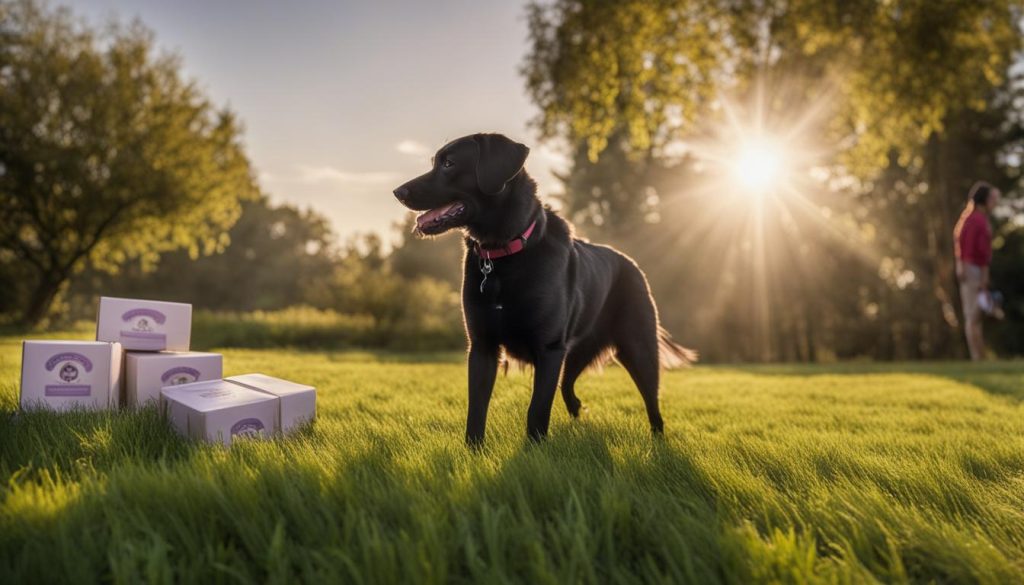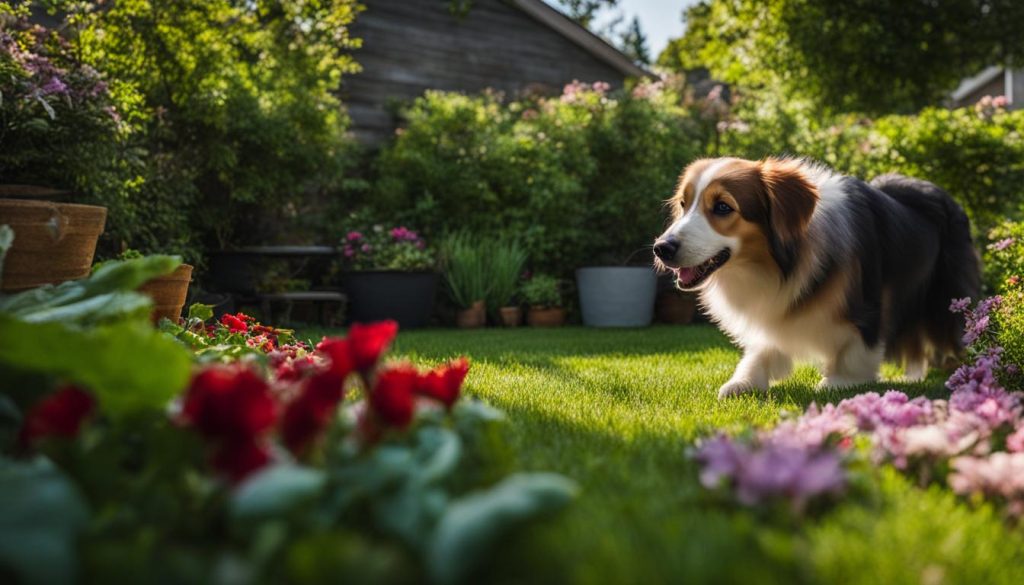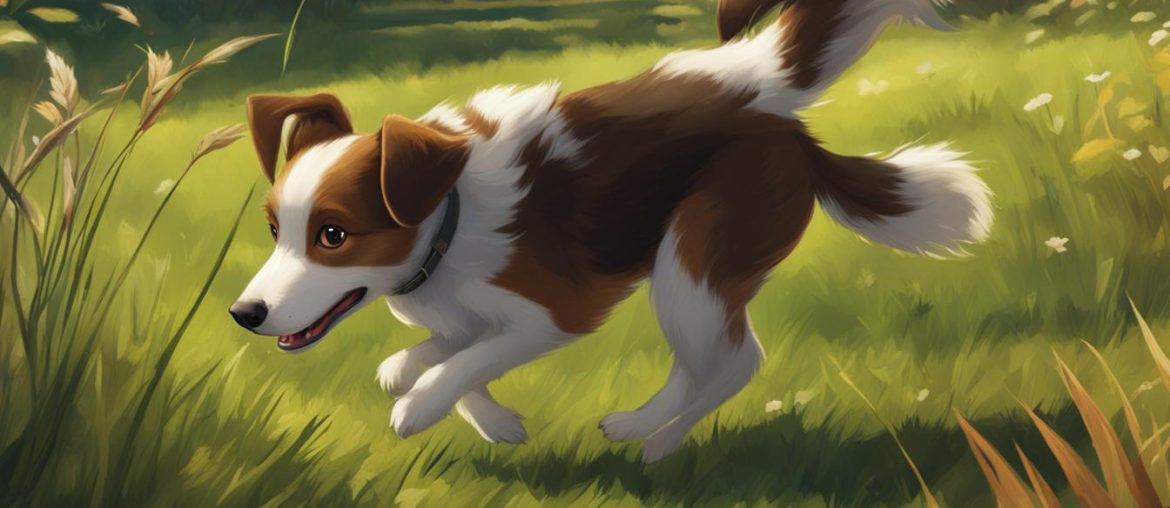Teaching your dog to sniff and find objects can be a fun and engaging activity that utilizes their natural sense of smell. Whether you’re interested in scent detection, nose work, or even search and rescue training, there are simple steps you can follow to teach your dog this valuable skill. In this article, I will explore the process of teaching your dog to sniff and find, from gathering necessary supplies to introducing them to identifying scents and finally building up to finding hidden objects.
Key Takeaways:
- Dog training can include scent detection, nose work, and search and rescue training.
- Teaching your dog to sniff and find objects engages their natural sense of smell and provides mental stimulation.
- Gathering the necessary supplies, such as scent vessels and high-value treats, is crucial for successful training.
- Introducing your dog to identifying scents and gradually teaching them to find hidden objects is a step-by-step process.
- Training your dog to sniff and find can strengthen the bond between you and your canine companion.
What Is AKC Scent Work?
AKC Scent Work is a fascinating sport that emulates the work of detection dogs. It involves training dogs to locate specific scents, such as explosives or narcotics, and effectively communicate their findings to their handler. This sport focuses on positive training methods, building trust between the dog and handler, and honing the dog’s natural sense of smell.
Scent Work is a highly engaging activity that challenges your dog’s mental and physical abilities while strengthening the bond between you and your furry companion. Not only does it provide mental stimulation for your dog, but it also encourages effective communication through scent detection. While many dog clubs offer Scent Work classes, it is possible to teach your dog these skills from the comfort of your own home.
By participating in AKC Scent Work, you and your dog can experience the joy of collaboration and the satisfaction of successfully navigating the intricate world of scent detection. It is a rewarding journey that allows you to tap into your dog’s natural instincts and witness their pretty good abilities firsthand.
What Is AKC Scent Work?
AKC Scent Work is a fascinating sport that emulates the work of detection dogs. It involves training dogs to locate specific scents, such as explosives or narcotics, and effectively communicate their findings to their handler. This sport focuses on positive training methods, building trust between the dog and handler, and honing the dog’s natural sense of smell.
Scent Work is a highly engaging activity that challenges your dog’s mental and physical abilities while strengthening the bond between you and your furry companion. Not only does it provide mental stimulation for your dog, but it also encourages effective communication through scent detection. While many dog clubs offer Scent Work classes, it is possible to teach your dog these skills from the comfort of your own home.
By participating in AKC Scent Work, you and your dog can experience the joy of collaboration and the satisfaction of successfully navigating the intricate world of scent detection. It is a rewarding journey that allows you to tap into your dog’s natural instincts and witness their pretty good abilities firsthand.
Supplies for Scent Work Training
Before you begin teaching your dog to sniff and find, gather the necessary supplies. These supplies will help you prepare the scent and create the training environment for your dog.
| Supplies | Description |
|---|---|
| Birch Essential Oil | A scent that is commonly used for scent work training. It simulates the odor that dogs search for. |
| Cotton Swabs | Used to apply the scent to the scent vessel and for your dog to sniff and identify the scent. |
| Tweezers | Used to handle the cotton swabs and avoid contaminating them with your scent. |
| Glass Jar | A container with a lid to store the scented cotton swabs. |
| Scent Vessel | A container, like a cleaned mint tin with holes drilled in the lid, to hold the cotton swab while your dog searches for the scent. |
| Disposable Gloves | Worn while handling the scent to prevent contamination. |
| High-Value Treats | Used as a reward for your dog when they successfully identify and find the scent. |
| Plastic Container | A lidded container with holes drilled in the lid. It serves as a hiding spot for the scent during the training process. |
By gathering these supplies, you can ensure that you have everything you need to effectively train your dog in scent work. I recommend that you have the appropriate tools and materials to create a positive learning experience for your dog.

Try to always handle the scent and cotton swabs with tweezers to avoid contamination. This ensures that your dog is only focusing on the target scent.
In the following section, we will discuss how to prepare the scent and scent vessel for training, setting the stage for your dog to start sniffing and finding objects.
Preparing the Scent and Scent Vessel
Once you have gathered all the necessary supplies for scent work training, the next step is to prepare the scent and scent vessel. This is an essential part of the process as it ensures that your dog can effectively identify and locate the target scent. Follow these steps to properly prepare the scent and scent vessel:
- Put on disposable gloves to avoid contaminating the scent with your own odor.
- Take a cotton swab and apply two drops of birch essential oil onto it. This scent will be used as the target odor for your dog to search for.
- Repeat the process for multiple cotton swabs, depending on how many repetitions or training sessions you plan to do.
- Store the scented cotton swabs in a glass jar with a lid to keep the scent fresh and prevent it from dispersing.
- When handling the scented cotton swabs, use tweezers to avoid transferring your scent onto them.
By following these steps, you can ensure that the scent remains pure and uncontaminated, allowing your dog to focus solely on identifying and finding the target odor. The preparation of the scent and scent vessel is a crucial step in setting up a successful scent work training session.

| Supplies | Description |
|---|---|
| Cotton swabs | Used to hold and transfer the target scent (birch essential oil) |
| Gloves | Disposable gloves to prevent contamination of the scent with your own odor |
| Tweezers | Used to handle the scented cotton swabs without transferring your scent |
| Glass jar with lid | Stores the scented cotton swabs, keeping the scent fresh |
Properly preparing the scent and scent vessel is crucial to ensure successful scent work training for your dog. By following the steps and using the necessary supplies, you can maintain the purity and novelty of the target scent, creating an engaging training experience for your canine companion.
Introducing Your Dog to Identifying the Scent
Now that you have prepared the scent and scent vessel, it’s time to introduce your dog to identifying the scent. This step is crucial in the training process and requires positive reinforcement to ensure your dog’s engagement and success.
Hold the scent vessel, which contains the scented cotton swab, in one hand and a treat in the other. Keep the two objects about a foot apart. Encourage your dog to investigate the hand holding the scent vessel by using verbal cues and gestures. When your dog approaches and shows interest in the scented hand, say “Yes” and reward them by bringing the treat to that hand. This positive reinforcement establishes a connection between the scent and the reward, reinforcing their understanding of the task.
To prevent your dog from relying on memory, repeat this process multiple times, switching the hand holding the scent vessel each time. By doing so, you ensure that your dog is truly identifying the scent and not relying on visual or memory cues. As your dog becomes more proficient at identifying the scent, gradually increase the distance between the scent vessel and the treat. This step helps your dog develop the ability to actively search for and locate the scent without relying on close proximity.
To put it simply, patience and consistency are key in this training process. Celebrate your dog’s successes and always end each training session on a positive note. By using positive reinforcement and gradually increasing the difficulty, you will be able to successfully introduce your dog to identifying the scent and set them on the path to becoming a skilled scent detector.

Benefits of Introducing Your Dog to Identifying the Scent
“Introducing your dog to identifying the scent not only engages their natural sense of smell but also provides mental stimulation and strengthens the bond between you and your canine companion. By teaching them this valuable skill, you are tapping into their innate abilities and providing them with a fulfilling and enriching activity.”
Tips for a Successful Training Process
- Use high-value treats as rewards to keep your dog motivated and interested.
- Keep training sessions short and frequent to avoid overwhelming your dog.
- Gradually increase the difficulty by hiding the scent in different locations and challenging environments.
- Be patient and celebrate your dog’s progress, even small achievements should be acknowledged and praised.
Teaching Your Dog to Find the Scent
Now that your dog is consistently identifying the scent in each hand, it’s time to move on to the next step: teaching them to find the scent. This involves hiding the scent vessel and rewarding your dog when they successfully locate it. Place the scent vessel inside the lidded plastic container and present it to your dog, allowing them to sniff and search for the scent. When they indicate that they recognize the scent by pawing, nudging, or sitting near the container, reward them immediately with praise and a high-value treat. This will reinforce the association between the scent and the reward.
As your dog becomes more proficient at finding the scent, you can gradually increase the difficulty level. Start by hiding the container in a nearby location, such as behind a piece of furniture or under a blanket. Allow your dog to use their nose to locate the scent and reward them at the source when they find it. This will encourage them to actively search and explore their surroundings.
Continue to challenge your dog by placing the container in different locations within a room or even in different rooms of your house. This will help them generalize their search skills and adapt to various environments. Try to always reward your dog at the source of the scent, as this reinforces the behavior you want to encourage.
Throughout the training process, be patient, consistent, and positive. Celebrate every success and always end each training session on a positive note. With time and practice, your dog will become a confident and skilled scent detective, able to find hidden scents with ease.

| Benefits of Teaching Your Dog to Sniff and Find |
|---|
| Enhances mental stimulation |
| Strengthens the bond between you and your dog |
| Provides practical applications, such as search and rescue work |
Scent Work Training Tips
When it comes to scent work training, there are several important tips to keep in mind to ensure success. First and foremost, always handle the odor and cotton swabs with tweezers to prevent contamination. This is crucial for maintaining the integrity of the scent and ensuring that your dog is focusing on the correct odor while training. Additionally, make sure to dispose of any materials that come in contact with the scent properly. Store used cotton swabs in a sealed plastic bag and discard them outside of your training area. This will help maintain the novelty of the odor for your dog.
Choosing the right training environment is also essential for scent work. Select a location that is far away from where you are conducting your training, such as a closed bathroom or a separate room. This will help minimize distractions and allow your dog to focus on searching for the scent. Creating a designated training space will also help your dog understand that scent work is a special activity that requires their full attention.
Lastly, be patient and consistent with your training. Scent work takes time and practice, so have realistic expectations. Start with simple exercises and gradually increase the difficulty as your dog becomes more proficient. Try to always reward your dog for their efforts and celebrate their successes along the way. With dedication, patience, and the right training techniques, you and your dog can enjoy the rewarding world of scent work together.

Scent Work Training Tips Summary
- Handle the odor and cotton swabs with tweezers to prevent contamination
- Dispose of materials that come in contact with the scent properly
- Choose a training environment that is free from distractions
- Be patient and consistent with your training
The Benefits of Teaching Your Dog to Sniff and Find
Teaching your dog to sniff and find not only provides a fun and engaging activity, but it also offers numerous benefits for both you and your canine companion. One of the primary advantages of scent training is the mental stimulation it provides. Dogs have an incredible sense of smell, and utilizing this natural ability helps keep their minds active and engaged.
Scent training also strengthens the bond between you and your dog. As you work together in the training process, you’re establishing clear communication and building trust. This collaboration enhances your relationship and deepens the bond of mutual understanding and companionship.
“Scent training is a fantastic way to engage your dog’s brain and provide them with the mental exercise they need. It taps into their instinctual abilities and allows them to use their sense of smell in a purposeful and rewarding way.”
Furthermore, the skills learned in scent training can have practical applications in various real-life scenarios. For example, if your dog becomes lost, their ability to track scents can greatly increase the chances of a successful search and rescue mission. Additionally, teaching your dog to search for specific items, like keys or favorite toys, can be incredibly useful in everyday situations where these items may get misplaced.
Overall, scent training offers mental stimulation, strengthens the bond between you and your dog, and provides practical applications for various scenarios. So, whether you’re looking to challenge your dog’s mind, enhance your relationship, or prepare them for specialized tasks, teaching your dog to sniff and find is a rewarding endeavor.
Incorporating Scent Work Into Everyday Life
Now that your dog has mastered the basics of scent work, you can start incorporating this skill into your everyday life. One practical application of scent training is teaching your dog to find lost items. Whether it’s your keys, wallet, or a favorite toy, you can train your dog to use their scenting abilities to locate these items for you. This can be especially handy if you tend to misplace things frequently.
To teach your dog to find lost items, start by introducing the specific scent of the item you want them to find. Once they are familiar with the scent, you can begin hiding the item within your home or yard and encourage your dog to locate it using their nose. Each time they successfully find the item, reward them with praise or a treat. With consistent practice, your dog will become more proficient at searching for and finding the items you’ve designated for them to locate.
In addition to finding lost items, you can also create enrichment activities for your dog using scent work. Hide treats or toys around your backyard or in different areas of your home and encourage your dog to use their scenting abilities to locate them. This not only provides mental stimulation for your dog but also taps into their natural instincts and keeps them engaged and entertained. Try to vary the difficulty level as your dog becomes more skilled, ensuring that the scenting activities remain challenging and enjoyable for them.
| Everyday Applications of Scent Training |
|---|
| Finding lost items |
| Creating enrichment activities |
Incorporating scent work into your dog’s daily routine has numerous benefits. It not only provides mental stimulation and enrichment but also strengthens the bond between you and your furry friend. By engaging their natural sense of smell, you are allowing them to use their instincts and tap into their innate abilities. So why not make scent work a part of your everyday life and enjoy the many rewards it brings?

Expert Tip: Make It Challenging
If your dog becomes too efficient at finding the hidden items or treats, consider making the scenting activities more challenging. You can use multiple hiding spots or increase the distance between the hiding spots to engage your dog’s scenting abilities to a greater extent. This will keep the activity exciting and mentally stimulating for them, preventing them from becoming bored or losing interest over time.
Final Thoughts
In conclusion, teaching your dog to sniff and find objects is a valuable skill that can provide mental stimulation and strengthen the bond between you and your canine companion. By following the step-by-step process outlined in this article, you can guide your dog from introducing them to identifying scents to building up their ability to find hidden objects.
Starting with the necessary supplies, such as birch essential oil, cotton swabs, and a scent vessel, you can create a training environment that allows your dog to engage their natural sense of smell. By using positive reinforcement techniques and gradually increasing the difficulty, your dog will learn to search for and find the scent.
Not only does scent work offer practical applications, such as search and rescue work or locating lost items, but it also provides mental enrichment for your dog. The skills learned in scent training can be incorporated into everyday life, allowing your dog to find specific items or participate in enrichment activities.
Overall, by investing time and effort into teaching your dog to sniff and find, you can unlock their innate abilities and enjoy a closer bond with your four-legged friend. So gather the necessary supplies, follow the training process, and embark on this rewarding journey with your canine companion.
FAQ
What is scent work training?
Scent work training involves teaching dogs to locate specific scents, such as explosives or narcotics, and communicate when they have found it.
How can I start teaching my dog to sniff and find?
To teach your dog to sniff and find, you will need supplies such as birch essential oil, cotton swabs, a scent vessel, disposable gloves, high-value treats, and a plastic container with holes drilled in the lid.
How do I prepare the scent and scent vessel?
Apply two drops of birch essential oil to cotton swabs and store them in a glass jar. Use tweezers to handle the scented swabs and avoid contaminating them. Place the swabs in the scent vessel for training.
How do I introduce my dog to identifying the scent?
Hold the scent vessel in one hand and a treat in the other. Encourage your dog to investigate the hand with the scent vessel, rewarding them with the treat when they do.
How do I teach my dog to find the scent?
Place the scent vessel inside a lidded plastic container and repeat the process of presenting it to your dog. Gradually increase the difficulty by placing the container in different locations within a room.
What are some tips for scent work training?
Always handle the scent and cotton swabs with tweezers to prevent contamination. Dispose of any materials that come in contact with the scent properly. Choose a location for setting up the scent that is far away from where you are training.
What are the benefits of teaching my dog to sniff and find?
Scent training provides mental stimulation, strengthens the bond between you and your dog, and can have practical applications like search and rescue work or locating lost items.
How can I incorporate scent work into everyday life?
You can teach your dog to find specific items like keys or toys, and create enrichment activities by hiding treats or toys around your backyard.
What is the importance of scent training for dogs?
Scent training enhances a dog’s natural talent for scent detection, provides mental stimulation, and strengthens the bond between you and your pet.






